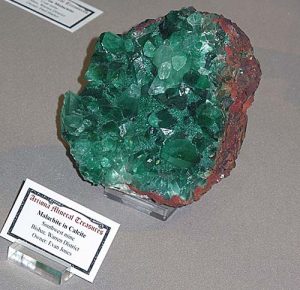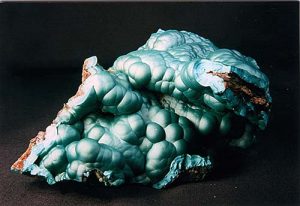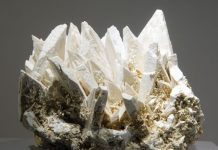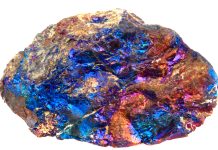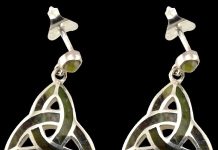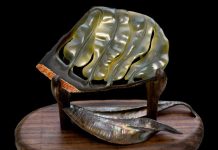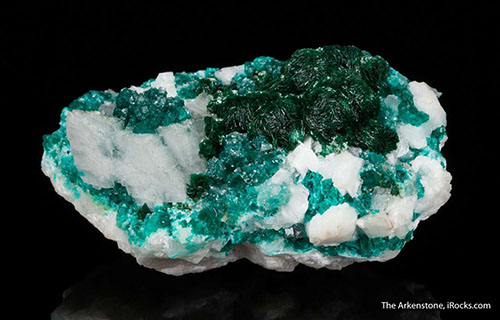
Editor’s Note: This is the first of a two-part series.
By Bob Jones
Green malachite is found in a pleasing variety of forms. In fact, the structure and form of malachite—its morphology—is what gives us such an interesting variety of specimens to collect. The amazing thing about malachite is that it seldom forms crystals of respectable size that are worth collecting! Yet, a mineral collection would somehow be incomplete without some form of lovely, green malachite.
In massive form, malachite occurs as solid, undulating bands of massive cutting-grade material, and is a popular gem material. This banded malachite, when cut and polished, reveals eye-pleasing, light- to dark-green patterns that are very decorative.
Malachite’s Secondary Spotlight
Malachite is also found as carpets of delicate, velvety needles on matrix that have a shimmering reflection. It forms stately stalactites in regal clusters. It can replace other minerals, adopting their crystal shape. Interestingly, malachite rarely develops discrete crystals of its own. In fact, these are so uncommon that dealers often refer to them as “primary” crystals—a misleading label. This term became popular in the late 1980s, when fine single crystals of malachite measuring 1 or 2 inches long in clusters were mined at the Mashamba copper mine, in Zaire. When they were introduced at major shows like Munich and Tucson, these discrete malachite crystals were quickly picked up by collectors.
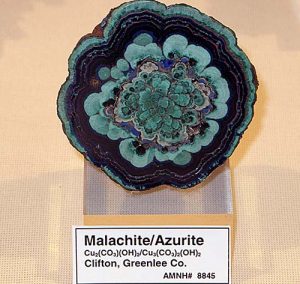
All types of malachite are secondary, since its copper atoms are derived from the decomposition of other copper species, most often chalcopyrite. Countless graceful specimens of malachite, with crystals ranging from an inch to many inches long, didn’t originally form as malachite. They started out as some other species. Slender, green, velvety beauties started out as azurite, the copper carbonate sister of malachite. Less commonly, fine octahedral cuprite crystals, measuring a fraction of an inch to over an inch on an edge, were either completely replaced by or heavily coated with green malachite.
But why does malachite form pseudomorphs after azurite, while the opposite replacement, azurite after malachite, is almost unknown? You have to compare the composition of malachite to azurite for an answer. Both are hydrous copper carbonates, so they are very closely related chemically. A molecule of azurite is composed of three copper ions, two carbonate radicals, and one hydroxide group: Cu3(CO3)2(OH)2. A molecule of malachite is composed of two copper ions, one carbonate radical, and one hydroxide group: Cu2CO3(OH)2. The molecular arrangement of malachite is more stable than that of azurite.
Composition Comparison Revelations
In both cases, the copper ions have a valence of two, meaning that there are two electrons in each atom’s outer electron shell. But the three-copper-ion arrangement is slightly less stable than the two-copper-ion arrangement in malachite, so it is easier for azurite to give up one copper ion and one carbon dioxide radical and become more stable than for it to take in these chemical components.
The end result is that azurite more easily changes into malachite under the right conditions. Note that many malachite pseudomorphs are slightly concave, a result of the reduction in necessary components. For the reverse—azurite replacing malachite—to happen, the malachite molecules would have to acquire more copper ions and carbonate radicals. This takes more energy, and is therefore far less likely to happen.
A number of copper deposits are very well known for their malachite pseudomorphs. Bisbee, Arizona, comes to mind immediately, as the Southwest mine produced some of the most handsome, multi-inch, bladed malachite pseudomorph crystals in groups of individual crystals that sit at odd angles on an iron oxide matrix.
In recent years, amazing malachite pseudomorph specimens after azurite—some of the world’s finest—have come from the Milpillas mine, in Sonora, Mexico. Actual mining of this deep deposit started in the 21st century, so its specimens are pretty new. Seven oxidized carbonate zones were discovered there, and from 2006 to 2012 the mine produced huge quantities of the world’s finest azurites and some of the world’s finest superb malachite pseudomorph specimens.
Milpillas Malachite Specimens Shine
Milpillas malachite occurred as velvety coatings, sometimes with brilliant azurite crystals. It was also found in marvelous pseudomorphs after azurite, in plates up to 10 inches across. These pseudomorphs often show a brilliant chatoyant luster. Such lovely specimens are considered some of the finest malachite pseudomorphs ever found.
Another interesting type of pseudomorph found at Bisbee consists of tiny, individual
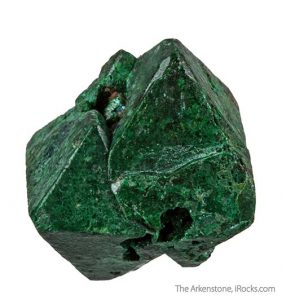
malachite-after-cuprite crystals scattered over a specimen. This feature is quite distinctive and helps identify unlabeled Bisbee specimens.
Malachite’s most common habit is to develop as needle crystals, tightly packed in a fanlike arrangement, in layers, which show up as bands in cross section. The bands vary in thickness and range from light to dark shades of green. The needle crystals of malachite that make up the layers, or bands, begin forming at what is called a “point of nucleation”, which almost all crystals need to get started. Crystals can form on any rough spot, fragment with a sharp edge, or bit of iron oxide, among other things. Electrical attraction can also play a role in this.
Some malachite, however, can develop without an obvious point of nucleation; it can actually start crystallizing freely in solution. This leads to a virtually invisible cluster of a few molecules, which becomes the center around which needle crystals grow. They radiate out in all directions, forming what we commonly call “spherules”. As they grow, they attach one to another, interfering with each other to form massive layers of undulating spherulites of malachite. When cut across the banding, the lovely, fanlike, compact needle structures of these spherules are obvious.
Formation of Fanlike Crystal Needles
Most crystals simply begin to grow using available molecules. This results in discrete crystals whose sizes depend on available material. But malachite is different. It seldom forms discrete crystals of good size. Instead, scientists say, developing malachite crystals “split”, diverging into tiny needles, packed together in a fanlike arrangement.
The fanlike malachite needles grow into tightly bonded spherules, which crowd together and bond, forming a solid mass. When the spherules stop growing and terminate, the top surface is rounded to some degree. The terms “botryoidal” (resembling a cluster of grapes) and “reniform” (kidney-shaped) are used to describe large to small undulating masses of spherules.
The surface of this malachite can range from lustrous to dull. It can also be coated with a thin layer of some other mineral, like copper oxide, which gives it a black surface color.
You may wonder why the bands of malachite differ in shades of green. You may also wonder why some banded malachite will separate easily between bands, while the bands in other malachite remain tightly bonded, regardless of any lapidary treatment. The simple answer is “impurities”.
Change in Ph Can Trigger Crystallization
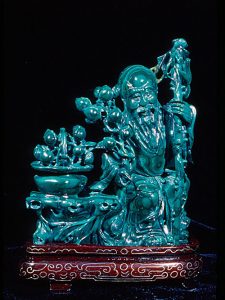
Like most minerals, malachite is secondary and forms from molecules released by the chemical weathering of earlier-formed copper minerals, like chalcopyrite. When copper ions end up in a solution, they are in company with countless other elements, compounds, and chemical radicals. That solution can undergo all sorts of changes in temperature, concentration and acidity. This determines which impurities will settle out. Eventually, the concentration of the copper ions is sufficient to join with carbonate derived from nearby limestone and hydroxide radicals, forming hydrous copper carbonate (azurite) or more stable malachite.
A change in the solution’s Ph can also trigger the crystallization of other minerals. These minerals are deposited on the malachite and interfere in the later development of spherule bands; therefore, a later-forming malachite band may not be able to bond strongly with a previously formed band, and the two will part under any stress.
The environment in which the malachite bands form can also affect color, as can impurities. More important is the size of the needle crystals, which will determine whether the green color we see is light or dark or some shade in between. The needles can range from extremely narrow to slightly wider, which affects how light is absorbed and results in differing shades of green. All this contributes to the beauty of this copper carbonate gem. Almost as exciting are the undulations of the bands, from gentle to really radical curves. They sometimes form bull’s-eyes and dramatic curves of color.
Arrangement of Crystals Adds to Malachite’s Appeal
One other feature of banded malachite must be mentioned, as it adds so much to the beauty of any given banded malachite: the effect of the needle crystals on light because of the angular arrangement of the crystals, their size, and transparency. All these factors play a role in how the malachite reacts when moved around under a bright light. What we see is a lovely, shimmering light reflection we call “chatoyance”. Malachite is already beautiful because of its light and dark, swirling and undulating banding and light- to dark-green shades. Add to these features the shimmering chatoyance you see in some banded malachite, and you have in hand a most attractive malachite gem.
Today, collectors and lapidaries are enjoying an amazing influx of wonderful, velvety, stalactitic and massive malachite from deep in Africa. We have not seen such quantities of malachite since the discovery of huge malachite masses during copper mining in Russia’s Ural Mountains, nearly 200 years ago. These two localities have been responsible for huge quantities of some of the finest malachite ever found. We are also blessed with malachite from the recently opened copper mine at Milpillas. In 10 years, this mine produced some of the finest azurite and malachite pseudomorphs ever found anywhere.
Part II of this article will describe amazing lapidary work done with Russian malachite and the currently productive malachite deposits in Central Africa. Check out Part II>>>
Author: Bob Jones
 Holds the Carnegie Mineralogical Award, is a member of the Rockhound Hall of Fame, and has been writing for Rock & Gem since its inception. He lectures about minerals, and has written several books and video scripts.
Holds the Carnegie Mineralogical Award, is a member of the Rockhound Hall of Fame, and has been writing for Rock & Gem since its inception. He lectures about minerals, and has written several books and video scripts.


